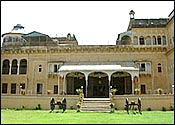|
|
|
|
|
|
|
|
|
| Dundlod Introduction |
|
 This destination is in the heart of Shekhawati Region, founded in 1750 and about 7 km from Nawalgarh. Visiting this village is like visiting an open-air art gallery that has not changed much since the time it was built. Dundlod is situated in the Shekhawati region of Rajasthan , India . Famous for its fort and havelis, this tiny village extends between latitude 28.06° in the north and longitude 75.20° in the east. Dundlod can be reached by road from Delhi , Jaipur, and Bikaner . This destination is in the heart of Shekhawati Region, founded in 1750 and about 7 km from Nawalgarh. Visiting this village is like visiting an open-air art gallery that has not changed much since the time it was built. Dundlod is situated in the Shekhawati region of Rajasthan , India . Famous for its fort and havelis, this tiny village extends between latitude 28.06° in the north and longitude 75.20° in the east. Dundlod can be reached by road from Delhi , Jaipur, and Bikaner .
Want to visit Dundlod? We at StayResIndia.com , a leading inbound tour operator in India , promote tourism in Rajasthan and can book hotels and resorts there as per your budget. We maintain very good professional relationship with all the major hotel chains and independent properties in India .
|
|
|
Top ˆ |
|
|
| Dundlod Tourist Attractions |
|
|
| § Dundlod Fort |
|
The fort of Dundlod is an embodiment of the cultural amalgamation of the Rajputana and Mughal Schools of Art and Architecture. Its motif of flowers and foliage, minarets, mythological paintings, archaic furniture, wall hangings of arrows and shields have remained unchanged since ages. Staying in Dundlod Fort is almost like living through the days of James Tod who once described the splendors of Rajasthan.
|
|
|
| § Diwan Khana |
|
The Diwan Khana is built in the Mughal architectural style and is furnished with Louis the XIV furniture. It has a magnificent library, with a very rich collection of rare books on Indian history. One can see the family portraits of the thakurs, which remind one of the times gone by. Above this lies the Duchatta from where the ladies watched the court ceremonies in purdah.
|
|
|
| § Tunganram Goenka |
|
The Tuganram Goenka Haveli is often locked but one can see fine mirror work above the windows on the upper walls of the courtyard. Finely preserved paintings under the eaves mostly comprise portraits in round frames. The haveli opposite this one is interesting, as the work could not be completed and it is possible to see how the artist sketched the drawings before adding color. Pictures include those of an elephant, a camel and its rider, and a horse.
|
|
|
|
|
Top ˆ |
|
|
|
|











